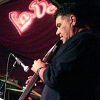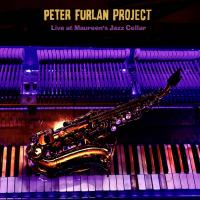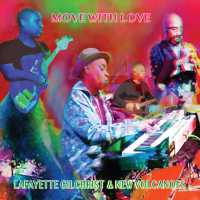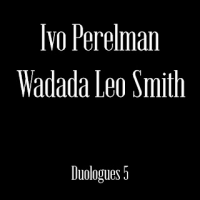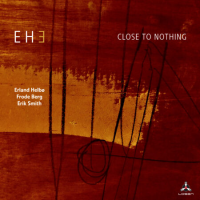Home » Jazz Articles » Album Review » ARC Trio and the John Daversa Big Band: ARCeology: The M...
ARC Trio and the John Daversa Big Band: ARCeology: The Music of MSM Schmidt
It starts with quality compositions, of course. German composer MSM Schmidt has again written free-flowing melodic tunes, which are as diverse as they are complex. The former big band drummer has emerged as a prolific and progressive composer that has intelligently provided spacious opportunities for improvisation. Schmidt's sharp sense of vision paves the way for inventive collaborators to expand with fresh ideas and directions. Schmidt turned to Jimmy Haslip and Scott Kinsey to produce this new creation. Haslip produced Schmidt's last three records. He has keenly chosen artists who brought something unique and earnest to the party. That has often included a host of big-name and multi-talented artists. For example, on Life (Laika Records, 2017) there are contributions from Allan Holdsworth, Dave Weckl, Virgil Donati, Mike Miller, Oz Noy, Gary Novak, Bob Mintzer, and many more. All of the previous Schmidt and Haslip projects have been finely crafted jazz records.
They wanted to dig deeper for ARCeology: The Music of MSM Schmidt. The resulting fusion & big band coalescence began with the inclusion of the richly dense fusion ensemble, the ARC Trio. The trio consists of keyboardist Kinsey, drummer Gergo Borlai, and Haslip on bass. Their last record, ARC Trio (Blue Canoe, 2018), was a significant voyage into fertile, imaginative, twenty-first-century fusion. The final piece of the puzzle, a big piece at that, was the John Daversa Big Band. Trumpeter Daversa had worked with Haslip and Schmidt in the past. That connectivity coupled with Daversa's directive on the horn section, proved to be crucial in aligning the many divergent pieces cohesively.
Ultimately, part of what makes this an exceptionally good record is that neither fusion nor big band is dominant. The two genres are impressively and beautifully merged together. It is an upbeat fast-moving, eight-song ride which never sleeps. Six of the tunes are enlightening compositions from Schmidt's previously released records. Here, they are broadly re-imagined as vastly compelling and genre-defying works of art.. The many changes, which dart in and out with spontaneous sensibility, are briskly navigated by a team led by Haslip and Kinsey. Borlai spiritedly kicked off the session with "Red and Gold" and, eight songs later, we can catch our breath. There are no ballads or tender little love songs. The music just keeps on coming, one wave after another. Steve Khan brought both his acoustic and electric guitar brilliance to "Red and Gold." Also, from outside the box, violinist Abby Young added a layer of richness and texture with every stroke. That is in addition to the big-band thunder, and each member of the trio finding moments to shine. And that is just the first song! Borlai is a powder keg of dynamite from start to finish. Versatile, he is predominantly known as a fusion drummer. He has often been favorably compared to drum icon Vinnie Colaiuta. He took to big band like a fish to water. Borlai was given a capacious role which he filled dynamically. That said, this is very much a group effort—actually more than one group,
The aptly named "Swing" has the big-band jumping and Daversa just smoking on his trumpet solo. It worked well to plant a tenor saxophone solo into the landscape. Guest Seamus Blake expanded the theme with high drive and energy. The ARC Trio dialed up the funk and reached a clear connection with the horn section. The only song not written by Schmidt is entitled "Quartet." The Kinsey-penned tune slides in on its own axis. There are surprises all the way through, such as Mer Sal infusing this piece by scatting the melody. Her free jazz voice became yet another new sound which teed up Blake to take another swing. Kinsey's high-tech keyboard work is shadowed by inventive percussion. Exceptional throughout the record with all the keyboard arranging and playing, Kinsey was impassioned on "Quartet." Another layer of sweet complexity developed from Kinsey's adroit gem with flautist Katisse Buckingham nailing a wicked solo.
"Qin Shi" features guitarist Nguyen Le. He is set up to flash into a powerful solo by the monstrous drumming of Borlai which first leads sharply into big band swagger. Le then builds to rock star electric status, springboarding off his own foundation of Far East culture, as well as the big-band setting. Another timely and well maneuvered change is put firmly yet gracefully into place by Haslip. He subtly grasps control with an intricately intense solo, which calmly simmers in the glow of the preceding energy. This imaginative Schmidt journey winds up where it started, with bouncy big-band energy. Next, the ARC Trio presents a compelling African vibe moving with daring and conviction, to be joined and celebrated by Le. The big band horns offer a curious and inventive counterpoint to the mysterious "Si Kitu." Judd Miller's EVI navigates the scene wistfully adding to the alluring soundscape.
Not many big-band records feature two top quality guitarists punching it out. But, again, this is not a traditional big-band record. Schmidt's original composition, "Mirrors," is keenly indicative of that. The process of genre infusion is jolted to life, with Mike Miller and Oz Noy as "Mirrors," sharply reflecting off a wall of big-band power. They seem to have left a connected image on the mirror, engrossingly signifying the complete maturation. The continued search for unspent imagery discovers a nineteen-sixties rock music staple. A vintage Hammond B-3 is uncovered, and now finds big-band turf to be virgin territory. So, for "Clark Kent," why not bring in the Super Hammond Man from the sixties? Yes, Brian Auger is still super in the twenty-first century.
This adventurous saga, led by the perceptive and invigorating writing of Schmidt, closes with a tune which might be at the zenith of his masterfully conceived structures. Khan again treats us to his heady electric and acoustic bends with a flavor that is uniquely Khan. Steve Tavaglione is recruited to dazzle with his soprano saxophone inside a fierce rhythm section. Like all of the other tunes, the directional compass is spinning. The changes are as abundant as their unexpected destinations. The pure magic of "Falling" culminates with powerful horns blending into a signature note attentive bass solo from Haslip, with Khan, Tavaglione, Kinsey, Borlai, and Daversa's Big Band still tightly absorbed in the mix, and outside the lines. From the beginning, the scope for this project was set with high expectations. Anyone looking for another ho-hum cookie cutter big band record should keep looking. The view from outside the box ignited new perspectives and empowered bold creativity. The illuminated vision became reality. A Grammy Award for Best Large Jazz Ensemble Album is justifiably in reach for this masterpiece of modern contemporary jazz.
Track Listing
Red and Gold; Swing; Quartet; Qin Shi; Si Kitu; Mirrors; Clark Kent; Falling,
Personnel
Jimmy Haslip
bassScott Kinsey
keyboardsGergo Borlai
drumsJohn Daversa
trumpetSteve Khan
guitarNguyen Le
guitar, electricMike Miller
guitarOz Noy
guitarBrian Auger
organ, Hammond B3Mer Sal
vocalsSeamus Blake
saxophoneSteve Tavaglione
woodwindsKatisse Buckingham
fluteJudd Miller
electronicsAlbum information
Title: ARCeology: The Music of MSM Schmidt | Year Released: 2022 | Record Label: Blue Canoe Records
Tags
PREVIOUS / NEXT
Jimmy Haslip Concerts
Support All About Jazz
 All About Jazz has been a pillar of jazz since 1995, championing it as an art form and, more importantly, supporting the musicians who make it. Our enduring commitment has made "AAJ" one of the most culturally important websites of its kind, read by hundreds of thousands of fans, musicians and industry figures every month.
All About Jazz has been a pillar of jazz since 1995, championing it as an art form and, more importantly, supporting the musicians who make it. Our enduring commitment has made "AAJ" one of the most culturally important websites of its kind, read by hundreds of thousands of fans, musicians and industry figures every month.













